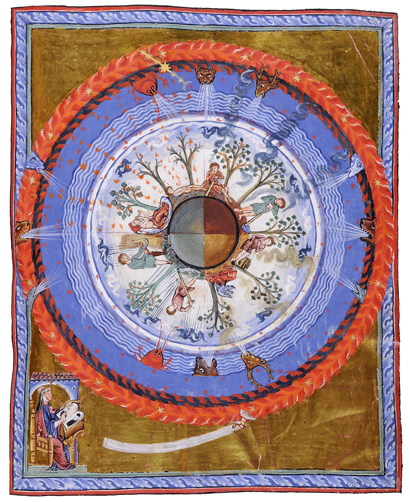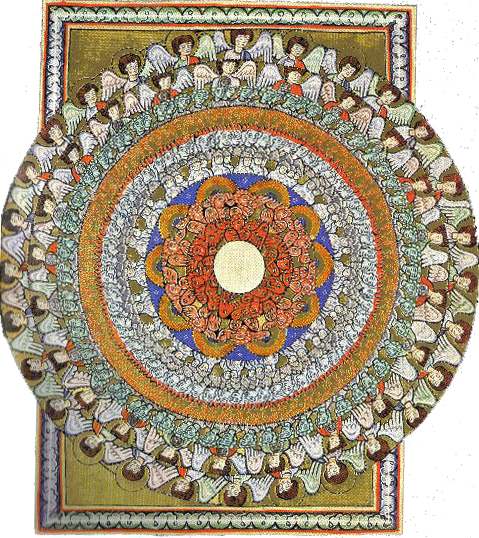A Multiplicity of Centers
Printed in the Summer 2017 issue of Quest magazine.
Citation: Swimme, Brian, "A Multiplicity of Centers" Quest 105:3(Summer 2017) pg. 34-35
It turns out that the earth is the center of the universe after all. So is everyplace else.
By Brian Swimme
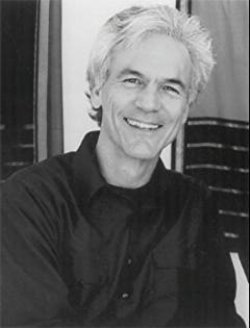 When the twentieth-century astronomer Edwin Hubble began watching the galaxies, he discovered that the galaxy clusters were moving away from us in all directions. This leads us to the startling conclusion that, in terms of cosmic expansion, we find ourselves at the center of the cosmos. This is indeed a strange and most unexpected development.
When the twentieth-century astronomer Edwin Hubble began watching the galaxies, he discovered that the galaxy clusters were moving away from us in all directions. This leads us to the startling conclusion that, in terms of cosmic expansion, we find ourselves at the center of the cosmos. This is indeed a strange and most unexpected development.
If such a discovery had been made during the medieval period of Europe, it would have caused no surprise at all, for the presiding worldview at that time put the earth at the center of the universe. To extend the earth’s centrality to the center of expansion of all the galaxy clusters would have made no great demands on the medieval mind.
But, of course, when Hubble made his discovery, we no longer lived within the medieval worldview. We had already learned from Copernicus that earth is not a fixed point at the center of the universe. Earth is one planet moving around one star, which itself is one of the three hundred billion stars of the Milky Way Galaxy, which in turn is one of a trillion galaxies in the wide universe. If we have learned anything over the last four hundred years since Copernicus initiated this great search, we have certainly learned that the earth is not a fixed center around which all the planets and stars revolved.
And yet here was this new revelation placing us at the center of the cosmic expansion of the galaxy clusters. Our Virgo Supercluster was not moving at all, and all of the other superclusters were moving away from us. What were we supposed to make of it?
Complicating our challenge is the consternation of the scientists who discovered the expansion. For if we could convince ourselves that it was Einstein’s secret hope to put us at the center of the universe, we could dismiss his and similar work as an ideological imposition upon the universe. On the contrary, for both Einstein and other scientists as well, the very discoverers of the cosmic expansion were repulsed by the idea, and they did everything they could to avoid accepting it. Disturbed by the implications of his theory, which suggested that the universe was either expanding or contracting, Einstein had introduced a “cosmological constant” into his equations to eliminate this problem, a decision he later called “the biggest blunder of my life.”
Had the cultural and personal biases of these scientists determined what they saw, they would not have found all the clusters of galaxies moving away from us so symmetrically that we were placed at the very center of this cosmic expansion. If they had been free to distort the data to fit their own preconceived notions about the large-scale nature of the universe, they would have announced that all the galaxies were fixed with respect to each other, which is what Einstein’s doctored equations suggested. Or, if they couldn’t have an unchanging universe, they might have preferred one in which all the galaxies were moving in the same direction, a Great River of galaxies. Then at least we would not be in any special place. Such a discovery would then fit into modern culture, for it would suggest we were insignificant, without cosmic meaning, just as Friedrich Nietzsche and Jean-Paul Sartre and Bertrand Russell and so many other modern philosophers taught. Earth would be just one bit of bark swept along with the Great Current.
What Hubble discovered did not fit modern culture’s preconceptions but in fact disrupted them. But instead of altering the data, he published it. He offered no philosophical justification for or against the data. He simply made public what he had discovered there at the cutting edge of human awareness: in terms of the universe as a whole and its fifteen-billion-year expansion, we happen to find ourselves at the very center.
Hubble’s discovery is not a contradiction of what Coperni cus learned; Hubble’s discovery is instead the completion of the cosmological exploration that Copernicus started. Copernicus initiated an investigation that removed the earth from the center of the universe, then removed the sun from the center, and then removed everything from the center. But after 400 years of empirical inquiry, a great reversal has taken place, one that shows us the center in a universe vastly huger than the solar system and nearby stars Copernicus and Galileo were aware of. We do not return to the cozy medieval geocentric world but enter an immense evolutionary cosmos, a cosmos that is centered on its own expansion. In order to fully appreciate this new understanding of the cosmic center, we must now deal with the seeming paradox at the heart of the data.
I’ve presented two discoveries that seem in conflict with each other. First, in terms of the light from the beginning of time, which was first detected by Penzias and Wilson, the birthplace of the universe is fifteen billion light-years away from us. Second, in terms of the expansion of the galaxies, which is Hubble’s discovery, we are at the very center of the universe. We need to consider this strange situation, where we are simultaneously at the center of the cosmic expansion and fifteen billion light-years away from the origin of the cosmic explosion. The paradox is this: how can we be both at the center and fifteen billion light-years away from the center?
We have such difficulties with this discovery because our minds have been shaped and educated in a culture firmly rooted in the Newtonian worldview. Even though we now know Newtonian physics is not adequate for complete understanding of the vast evolutionary universe that was discovered after Newton’s death, we are nevertheless stuck with Newtonian consciousness because it forms the foundation of our major institutions—including our educational systems. The challenge of understanding an Einsteinian universe is a real challenge indeed. We need to reinvent our very minds so that we do not distort the discoveries by holding them in Newtonian categories that are unable to touch the truth we have discovered.
To give a single example that bears on our discussion of the center: When we hear that the universe began in a great explosion fifteen billion years ago, we picture this as something like a Fourth of July fireworks explosion. First there is just empty space, then there’s this great explosion of colors in all directions. We are forced into picturing the birth of the universe in this way, because Newtonian cosmology regarded the universe as a giant fixed space inside of which things move about and gather together and so forth. The shaping of our minds in childhood already compels us to pic ture the birth of the universe as an explosion taking place in an already existing space.
But this understanding of the universe’s beginning is both false and utterly misleading. The birth of the universe means not only the birth of all the elementary particles of the universe and not only the birth of all the light and energy of the universe, it also means the birth of the space and time of the universe. There is no preexisting Newtonian space into which the universe explodes forth. There is no external Newtonian timepiece clicking away outside the universe. Space and time erupt together with mass and energy in the primordial mystery of the universe’s flaring forth.
The simplest way to see the inadequacy of our mind’s Newtonian assumptions concerning the universe’s beginning is to ask a simple question. When I picture the cosmic birth as some kind of explosion that is taking place off in the distance, away from me, away from where I am observing it, just where am I standing? What provides the platform for my feet? How is it that I can stand outside the universe and watch its birth if I myself, from the beginning, am woven into this birth?
A reeducation of the mind is necessary to make sense of what we have discovered. The central archetypal pattern for understanding the nature of the universe’s birth and development is omnicentricity. The large-scale structure of the universe is qualitatively more complex than either the geocentric picture of medieval cultures or the fixed Newtonian space of modem culture. For we have discovered an omnicentric, evolutionary universe, a developing reality which from the beginning is centered upon itself at each place of its existence. In this universe of ours, to be in existence is to be at the cosmic center of the complexifying whole.
If there are Hubble-like beings in the Hercules Cluster of galaxies seven hundred million light-years away, and such creatures are pondering the universe from that perspective, they will also discover that the galaxies in the universe are moving away from them. They will thus conclude on the basis of this evidence that they are at the center of the universe’s expansion, and they will be correct. Our Newtonian minds might experience discomfort in the task of appropriating this knowledge, but our personal difficulties do not change the nature of this universe. Just as Einstein’s first reaction, when he was given a glimpse of our omnicentric evolutionary cosmos, was to pull back and insist the universe could not be like that, so too in our own struggle we sometimes wish that the universe were not so complex, not so mysterious. But the universe will be what it will be regardless of whether or not we humans accept it as it is.
There is one image in the scientific literature that can give some assistance in the journey into an omnicentric universe. I offer it with some misgivings because the image, however helpful in some ways, is also inadequate in others, as I will point out. My hope is that it can help us take a first step out of the false view of the universe as a fixed space. And perhaps it might help awaken in others more adequate images of the nature of the universe that will become a regular part of our cosmological education in the future.
Imagine you are inside a loaf of raisin bread as it is being baked. The crucial point is to begin your imaginal work from within the process rather than outside of it. So we have to forget the nagging Newtonian questions concerning the oven, or the loaf’s crust, or any other concern that arises when we attempt to understand the process from outside. We are inside a cosmic process; even our thoughts about this process are simply yet another interesting current of microevents taking place inside the great macroevent of the fifteen-billion-year development.
So in this particular raisin bread image, we need to focus our imaginations on being in the very midst of the baking raisin bread. In particular, imagine yourself on a raisin and just look around. You will see that all the other raisins are moving away from you as the bread bakes, so that in terms of the bread’s expansion you find yourself at the very center. And anyone else on any other raisin throughout the loaf would come to a similar conclusion. Hence we have in this raisin loaf a model for an omnicentric reality.
But there’s more. Suppose you now try to determine whether or not you and your raisin are moving with respect to the bread itself. What you will find of course is that you’re frozen in place, for your raisin sits stationary with respect to the surrounding bread. And when you think about it a bit you realize that the very reason the raisins are moving away from you is because of the expansion of the bread. You and your raisin are not even moving; it’s the space in between the raisins that is growing larger.
And that, precisely, is how we understand the cosmic expansion. Not as the movement of galaxies through an already existing, fixed, Newtonian space. No, it’s much more interesting than that. The cause of the expansion of the universe is the space rushing into existence and flinging the clusters apart from each other. The size of each galaxy cluster stays the same, but the space in between the clusters expands in each instant, which results in an ever larger universe. That is our new understanding of the cosmos as a whole. A wild spirit breathes forth billowing chasms of space that explode the primeval fireball into a great growing immensity, at whose center we find ourselves.
In terms of the large-scale expansion of the universe, we are not moving. We are at the stable and unmoving center of this expansion. To be in the universe is to be at its center.
We are now in a position to show how the seeming paradox of being at the center and fifteen billion light-years from the center is in fact simply a counterintuitive feature of existence within an expanding universe. To see this, imagine we are back near the beginning of time, in fact imagine we are right at the moment when the fireball begins to break apart and release its light in all directions.
Now let’s follow the adventure of a photon, a particle of light, that is released very near to us. If the universe were not expanding, such a particle would fly across the distance separating us in a matter of moments. But since the universe is not just expanding, but is expanding extremely rapidly, the particle of light has to travel a much greater distance as time passes. It’s as if we were waiting at the top of the “down” escalator, and someone on the second step wants to reach us. The escalator begins moving very rapidly downward so that our friend, whose velocity never varies, is at first carried away from us. But as time passes, the escalator begins to slow down so that eventually our friend makes it all the way back up the stairs and joins us at the top.
Just this happened with the photons of light released at the early moments of the universe. Those photons that were traveling in our direction were carried away from us by the rapid expansion of the universe. But as with a ball thrown up toward the sky, whose initial speed upward slows down with every passing second, so too with the expansion of the universe, which began very rapidly but has been slowing down now for fifteen billion years. Those photons that were initially swept away from us kept traveling in our direction and eventually completed the journey to us.
In 1965, astronomers Arno Penzias and Robert Wilson detected photons that had been set in motion fifteen billion years ago, when the universe erupted into existence. These particles had been traveling toward us for fifteen billion years. So we can say that their place of origin now is fifteen billion light-years away from us. On the other hand, if we go back in time, we find that their place of origin back then is very close to where we are now.
Our own place here on Earth in the Virgo Supercluster was also an origin point of some of this primordial light, but we in the twentieth century do not see those particular photons. The matter we are composed of stayed here as the primordial light emanated away from us fifteen billion years ago. If there are intelligent beings elsewhere in the universe, they may be detecting those very photons of light that left from right here and that now arrive in their own distant planetary system with news of our place as the origin of the light from the beginning of time. We exist then at the very origin point of the universe, because every place in the universe is that place where the universe flared forth into existence.
Brian Swimme received his Ph.D. from the department of mathematics at the University of Oregon in 1978 for work in gravitational dynamics. He is the author of The Universe Is a Green Dragon, and coauthor of several books: Manifesto for a Global Civilization, with Matthew Fox; The Universe Story, with Thomas Berry; and The Journey of the Universe, with Mary Evelyn Tucker. He is presently on the faculty of the California Institute of Integral Studies in San Francisco. The material here has been excerpted from his book The Hidden Heart of the Cosmos: Humanity and the New Story, published by Orbis Books in 1996; www.orbisbooks.com .


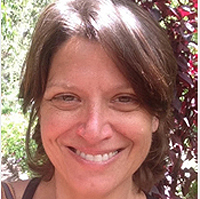 The sacred despacho ritual, a central practice of the Q’ero and Quechua peoples of the Andes, is used to honor Pachamama, Mother Earth, in daily ceremony. By creating a mandala-like bundle or offering, they create a gift to Pachamama and to spirit/creator. The gift is also used to transmit intentions of gratitude, using earth elements as the sacred messengers. It has been said that the paco, or priest, is a sacred chef, mixing ingredients from timeless recipes and creating a living prayer bundle, an act of love that honors a connection to all living beings.
The sacred despacho ritual, a central practice of the Q’ero and Quechua peoples of the Andes, is used to honor Pachamama, Mother Earth, in daily ceremony. By creating a mandala-like bundle or offering, they create a gift to Pachamama and to spirit/creator. The gift is also used to transmit intentions of gratitude, using earth elements as the sacred messengers. It has been said that the paco, or priest, is a sacred chef, mixing ingredients from timeless recipes and creating a living prayer bundle, an act of love that honors a connection to all living beings.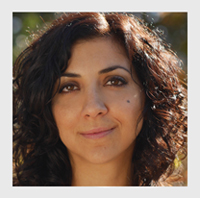 In recent years, the excessive use of the Internet, and especially of social media, has become one of the greatest causes of inaction. In this era of scrolling down, which has given the index finger a power it never dreamed of, the amount of time we spend watching videos on food recipes, political statements, fitness routines, outdoor wonders, and so on has replaced much of the time we actually dedicate to these activities.
In recent years, the excessive use of the Internet, and especially of social media, has become one of the greatest causes of inaction. In this era of scrolling down, which has given the index finger a power it never dreamed of, the amount of time we spend watching videos on food recipes, political statements, fitness routines, outdoor wonders, and so on has replaced much of the time we actually dedicate to these activities.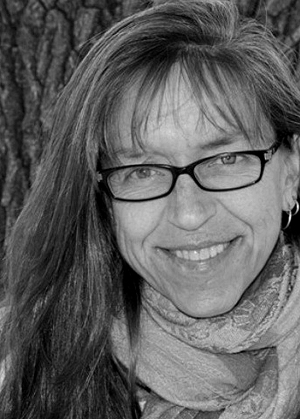 What is a prophet? If you ask most people, they will probably say that a prophet is someone who can predict the future.
What is a prophet? If you ask most people, they will probably say that a prophet is someone who can predict the future.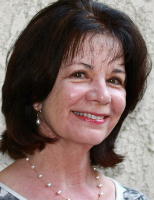 Hildegard of Bingen was no ordinary nun. The beloved Benedictine abbess stood at the epicenter of medieval Europe as a visionary and mystic. Famous for her visions of celestial wonders and vivid descriptions of an ordered and divine universe, she was a spiritual beacon to thousands of people who flocked to her monastery, seeking her advice and counsel.
Hildegard of Bingen was no ordinary nun. The beloved Benedictine abbess stood at the epicenter of medieval Europe as a visionary and mystic. Famous for her visions of celestial wonders and vivid descriptions of an ordered and divine universe, she was a spiritual beacon to thousands of people who flocked to her monastery, seeking her advice and counsel.